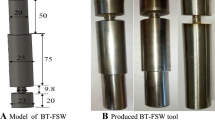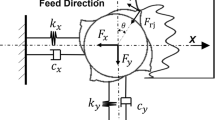Abstract
Semi-finishing is an important step to reduce the cutting vibration and deformation caused by the thin-walled stiffening rib parts of aeronautical inertial control products during the finishing process. In the semi-finishing process, the variation of cutting force is a key factor of machining deformation. A large number of samples considering the effect of cutting parameters, such as spindle speed, feed per tooth, and milling width were simulated by the finite element simulation software AdvantEdge to obtain the milling forces based on 7050 aluminum alloy (Al7050) for aviation. Moreover, the standardized Euclidean distance was introduced to the radial basis neural network model (RBF-NN) to develop an improved RBF neural network model (IRBF-NN), and a high-precision model to predict the effect of cutting parameters on the thin-walled semi-finishing milling forces was established based on the proposed IRBF-NN. Results show that the maximum relative errors of milling force obtained by the genetic algorithm–optimized BP neural network model (GA-BP-NN), RBF-NN, and IRBF-NN are 13.9%, 12.5%, and 4.1%, respectively. Accordingly, the proposed IRBF-NN has high accuracy and effectiveness to predict milling force for the semi-finishing of aerospace Al7050 thin-walled stiffening rib parts.














Similar content being viewed by others
Abbreviations
- F :
-
the total milling force
- F x :
-
the axial force
- F y :
-
the radial force
- F z :
-
the tangential force
- n :
-
the spindle speed
- f z :
-
the feed per tooth
- a e :
-
the milling width
- x :
-
the input vectors
- y :
-
the output vector
- xt :
-
the input vectors of the training samples
- x p :
-
the Pth input sample
- h :
-
the number of nodes in the hidden layer
- yt :
-
the output vectors of the training samples
- y n :
-
the normalized output vector
- N :
-
the sample size
- x t :
-
the sample input value
- y t :
-
the actual value
- \( {\hat{y}}_t \) :
-
the predicted value
- \( {\overline{y}}_t \) :
-
the average of the actual value
- v c :
-
the milling speed
- d :
-
the milling cutter diameter
References
Barile C, Casavola C, De Cillis F (2018) Mechanical comparison of new composite materials for aerospace applications. Composites Part B 162(1):122–128
Kotpalliwar S, Paruchuri P, Chatterjee D, Banavar R (2019) Discrete time optimal control with frequency constraints for non-smooth systems. Automatica 107(9):493–501
Gao HJ, Zhang YD, Wu Q, Song J (2017) An analytical model for predicting the machining deformation of a plate blank considers biaxial initial residual stresses. Int J Adv Manuf Technol 93:1473–1486
Rahmaan T, Noder J, Abedini A, Zhou P, Butcher C, Worswick MJ (2020) Anisotropic plasticity characterization of 6000- and 7000-series aluminum sheet alloys at various strain rates. International Journal of Impact Engineering 135.
Shi KN, Liu N, Wang SB, Ren JX (2019) Effect of tool path on cutting force in end milling. Int J Adv Manuf Technol 104:4289–4300
Jiang XH, Li BZ, Wang LF, Wang ZH, Li HL (2016) An approach to evaluate the effect of cutting force and temperature on the residual stress generation during milling. Int J Adv Manuf Technol 87:2305–2317
Ju GG, Song QH, Liu ZQ, Shi JH, Wan Y (2015) A solid-analytical-based method for extracting cutter-workpiece engagement in sculptured surface milling. Int J Adv Manuf Technol 80:1297–1310
Xiong YF, Wang WH, Jiang RS, Lin KY (2018) Machinability of in situ TiB2 particle reinforced 7050Al matrix composites with TiAlN coating tool. Int J Adv Manuf Technol 97:3813–3825
Zhang YR, Guo K, Sun J (2019) Investigation on the milling performance of amputating clamping__supports for machining with industrial robot. Int J Adv Manuf Technol 102:3573–3586
Ye GG, Xue SF, Jiang MQ, Tong XH, Dai LH (2013) Modeling periodic adiabatic shear band evolution during high speed machining Ti-6Al-4V alloy. Int J Plast 40(1):39–55
Wang B (2014) Simulation study on milling force and temperature in high-speed milling of 7050-T7451 aluminum alloy. Machine Tool & Hydraulics 42(16): 47–49
Sasi R, Subbu SK, Palani IA (2017) Performance of laser surface textured high speed steel cutting tool in machining of Al7075-T6 aerospace alloy. In: Surface and Coatings Technology, pp 1–33
Wang B, Liu ZQ, Su GS, Song QH, Ai X (2015) Investigations of critical cutting speed and ductile-to-brittle transition mechanism for workpiece material in ultra high speed machining. International Journal of Mechanical Sciences 1-57.
Hao WS, Zhu XS, Li XF, Turyagyenda G (2006) Prediction of cutting force for self-propelled rotary tool using artificial neural networks. J Mater Process Technol 180(1):23–29
Attanasio A, Andrea A, Tuğrul Ö, Elisabetta C (2019) Finite element simulation of high speed micro milling in the presence of tool run-out with experimental validations. Int J Adv Manuf Technol 100(1):25–35
Mebrahitom A, Choon W, Azhari A (2017) Side milling machining simulation using finite element analysis: prediction of cutting forces. Materials Today: Proceedings 4(4):5215–5221
Man X, Ren D, Usui S, Johnson C, Marusich TD (2012) Validation of finite element cutting force prediction for end milling. Procedia CIRP 1:663–668
Salimiasl A, Özdemir A (2016) Analyzing the performance of artificial neural network (ANN)-, fuzzy logic (FL)-, and least square (LS)-based models for online tool condition monitoring. Int J Adv Manuf Technol 87:1145–1158
Hanief M, Wani MF, Charoo MS (2016) Modeling and prediction of cutting forces during the turning of red brass (C23000) using ANN and regression analysis. Engineering Science and Technology, an International Journal 20:1220–1226
Dali MNAM, Ghani JA, Haron CHC (2017) Comparison between dynamic and non-dynamic cutting tool option in FEM simulation for producing dimple structure. Procedia CIRP 3:613–616
Arnaiz-González Á, Fernández-Valdivielso A, Bustillo A, Lacalle LNL (2016) Using artificial neural networks for the prediction of dimensional error on inclined surfaces manufactured by ball-end milling. Int J Adv Manuf Technol 83(5):847–859
Zheng BH (2017) Material procedure quality forecast based on genetic BP neural network. Modern Physics Letters B 31:19–21
Zhao B, Yu TY, Ding WF, Li XY, Su HH (2018) BP neural network based flexural strength prediction of open-porous Cu-Sn-Ti composites. Progress in Natural Science: Materials International 28:315–324
Gan GJ, Ng MKP (2017) K-means clustering with outlier removal. Pattern Recogn Lett 15(90):8–14
Draisma J, Horobeţ E, Ottaviani G, Sturmfels B, Thomas RR (2013) The Euclidean distance degree of an algebraic variety. Found Comput Math 16:99–149
Reyes H, Subramaniam S, Kaabouch N, Hu WC (2016) A spectrum sensing technique based on autocorrelation and Euclidean distance and its comparison with energy detection for cognitive radio networks. Comput Electr Eng 52:319–327
Ortiz-de-Zarate G, Sela A, Ducobu F, Saez-de-Buruaga M, Soler D, Childs THC, Arrazola PJ (2019) Evaluation of different flow stress laws coupled with a physical based ductile failure criterion for the modelling of the chip formation process of Ti-6Al-4V under broaching conditions. Procedia CIRP 82:65–70
Hank D, Azi Z, Ait Hocine S, Chaalal O, Hellal A (2014) Optimization of phenol adsorption onto bentonite by factorial design methodology. J Ind Eng Chem 4(20):2256–2263
Han Y, LYU GL, Zhang P (2016) Prediction model of cutting force and optimization of cutting parameters for 7050 aluminum alloy. Ordnance Material Science and Engineering 4(39):13–15
Funding
This work was financially supported by the National Major Science and Technology Projects of China (2018ZX04016001-010).
Author information
Authors and Affiliations
Corresponding author
Additional information
Publisher’s note
Springer Nature remains neutral with regard to jurisdictional claims in published maps and institutional affiliations.
Rights and permissions
About this article
Cite this article
Dai, Y., Zheng, X., Chen, X. et al. A prediction model of milling force for aviation 7050 aluminum alloy based on improved RBF neural network. Int J Adv Manuf Technol 110, 2493–2501 (2020). https://doi.org/10.1007/s00170-020-06044-9
Received:
Accepted:
Published:
Issue Date:
DOI: https://doi.org/10.1007/s00170-020-06044-9




